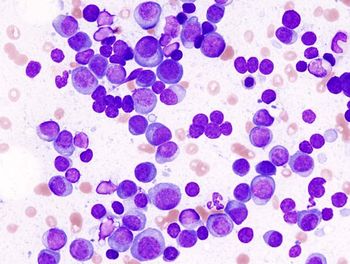
- Oncology Vol 30 No 4_Suppl_1
- Volume 30
- Issue 4_Suppl_1
(P011) Five-Fraction Stereotactic Body Radiation Therapy (SBRT) for Local Management of Metastatic Pancreatic Cancer
Here, we report superior local control with treatment of tumors that have smaller planning target volumes. Five-fraction SBRT offers quick and effective treatment with acceptable toxicity and minimal delay in delivery of systemic therapy.
Jonathan W. Lischalk, MD, Christen Elledge, Marie Gurka, MD, Aiwu He, MD, Sean P. Collins, MD, PhD, Michael Pishvaian, MD, Keith Unger, MD; Georgetown University Hospital; University of Louisville
BACKGROUND: The majority of patients with pancreatic cancer are diagnosed with metastatic disease at presentation. Nevertheless, local progression alone is responsible for up to 30% of deaths. An additional 10% to 25% of patients experience local progression in concert with distant spread. Thus, further exploration of effective methods of local control and palliation is essential in this metastatic population.
MATERIALS AND METHODS: This single-institution retrospective review analyzed 20 patients, all with pathologically diagnosed metastatic adenocarcinoma of the pancreas. Stereotactic body radiation therapy (SBRT) was delivered in five fractions to a total dose of 25–30 Gy. Local control was evaluated using Response Evaluation Criteria in Solid Tumors. Toxicity was graded using Common Terminology Criteria for Adverse Events version 3. Local control and overall survival (OS) were reported using the Kaplan-Meier method. Univariate analysis was performed using Student’s t-test.
RESULTS: The median patient age was 64 years, the majority of patients were male (60%), and the median pretreatment Eastern Cooperative Oncology Group, or ECOG, score was 1. The most common primary tumor location was within the pancreatic head (45%). Half of these patients received concurrent (within 1 week of SBRT) chemotherapy, and 95% received post-SBRT chemotherapy. Median time from pathological diagnosis to SBRT was 3.9 months. Rates of 12-month local control and OS were 47% and 53%, respectively. However, in patients with planning target volume (PTV) targets in the smallest 50% of the cohort (median PTV of 88 cc vs 261 cc), the 12-month local control rate was 78%. Freedom from local progression was significantly longer in this smaller PTV cohort (6.58 mo vs 2.53 mo; P = .02). Lastly, there was no reported grade 3–5 late toxicity without concurrent local progression.
CONCLUSIONS: As systemic therapies improve, the local management of pancreatic cancer will become more critical. Here, we report superior local control with treatment of tumors that have smaller PTVs. Five-fraction SBRT offers quick and effective treatment with acceptable toxicity and minimal delay in delivery of systemic therapy.
Proceedings of the 98th Annual Meeting of the American Radium Society -
Articles in this issue
Newsletter
Stay up to date on recent advances in the multidisciplinary approach to cancer.

















































































